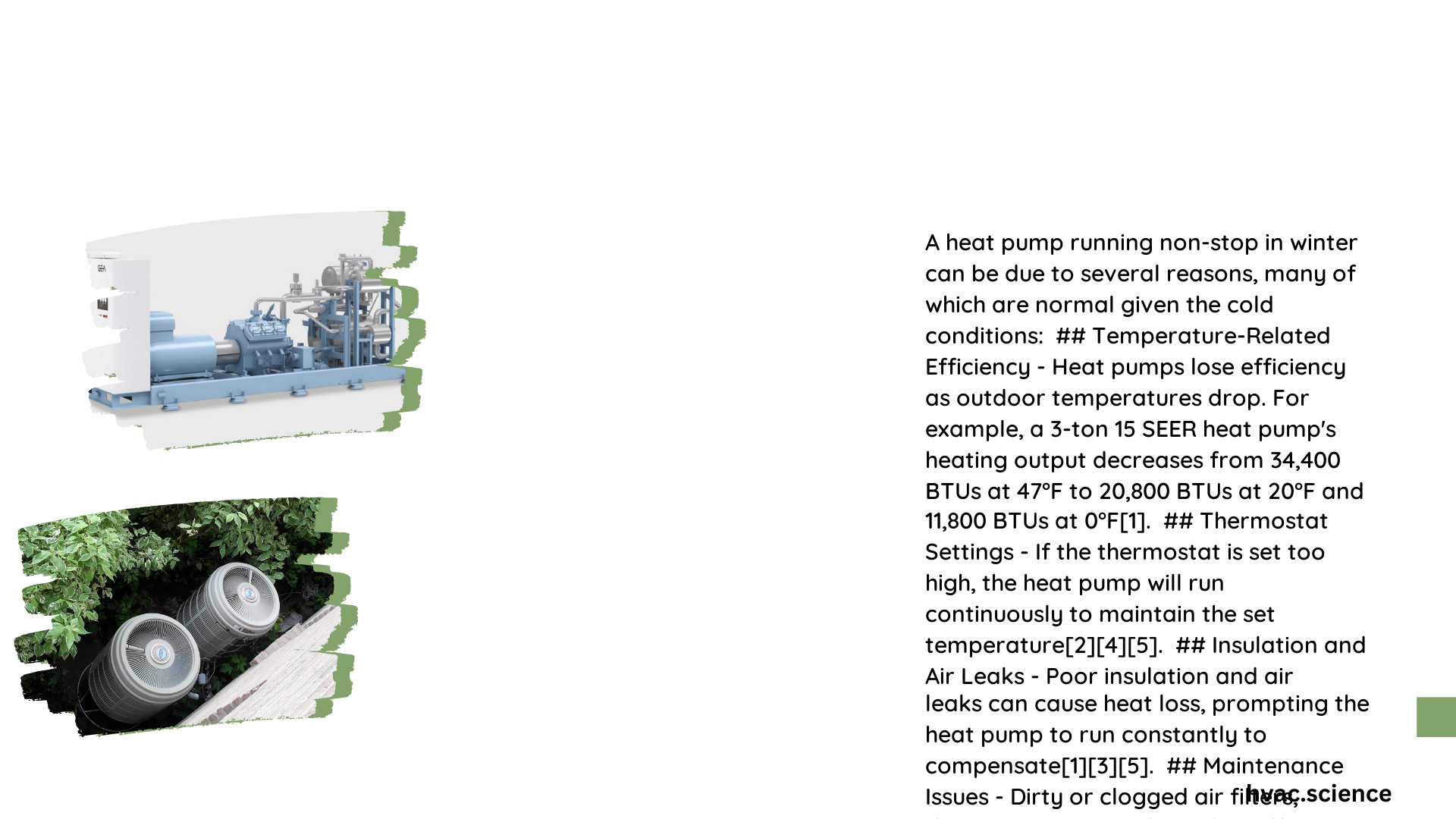A heat pump running non-stop in winter can lead to increased energy consumption, reduced efficiency, and potential system damage. This issue often stems from factors like extreme cold, improper settings, or maintenance problems. Understanding the causes and effects of continuous operation is crucial for homeowners to maintain optimal performance and energy efficiency during cold months.
Why Does My Heat Pump Run Continuously in Winter?
Heat pumps may run non-stop in winter due to several factors:
- Extremely low outdoor temperatures
- Incorrect thermostat settings
- Poor home insulation
- Dirty air filters
- Ice buildup on the outdoor unit
- Malfunctioning defrost cycle
When temperatures drop significantly, heat pumps work harder to extract heat from the cold air, potentially leading to continuous operation. Additionally, if your thermostat is set too low or your home lacks proper insulation, the system may struggle to reach the desired temperature, causing it to run constantly.
What Are the Effects of a Heat Pump Running Non-Stop?

Continuous operation of a heat pump in winter can have several negative consequences:
- Reduced Efficiency: As the heat pump works harder in cold weather, its efficiency decreases, leading to higher energy consumption.
- Increased Energy Bills: Continuous operation results in higher electricity usage, significantly impacting monthly energy costs.
- Accelerated Wear and Tear: Non-stop running puts extra stress on the system components, potentially shortening the heat pump’s lifespan.
- Decreased Comfort: Paradoxically, a constantly running heat pump may struggle to maintain consistent indoor temperatures.
How Much Energy Does a Continuously Running Heat Pump Consume?
The energy consumption of a heat pump running non-stop can vary based on factors such as the unit’s size, efficiency rating, and outdoor temperature. However, here’s a general estimate:
| Outdoor Temperature | Hourly Energy Consumption |
|---|---|
| Above 40°F (4°C) | 2-4 kWh |
| 25°F to 40°F (-4°C to 4°C) | 4-6 kWh |
| Below 25°F (-4°C) | 6-8 kWh or more |
In extreme cold, a heat pump running continuously could consume 144-192 kWh per day, potentially doubling or tripling your normal energy usage.
How Can I Diagnose a Heat Pump That Won’t Stop Running?
To diagnose a heat pump that’s running non-stop, follow these steps:
- Check the thermostat settings
- Inspect air filters for dirt and debris
- Examine the outdoor unit for ice buildup
- Look for air leaks around windows and doors
- Monitor the defrost cycle operation
- Observe the system’s performance at different temperatures
If you’re uncomfortable performing these checks, it’s best to consult a professional HVAC technician.
What Are the Solutions for a Continuously Running Heat Pump?
Here are some solutions to address a heat pump that won’t stop running:
- Adjust Thermostat Settings: Ensure your thermostat is set to an appropriate temperature and not in ’emergency heat’ mode.
- Improve Home Insulation: Seal air leaks and add insulation to reduce heat loss.
- Clean or Replace Air Filters: Regularly maintain air filters to ensure proper airflow.
- Clear Ice Buildup: Gently remove ice from the outdoor unit, being careful not to damage the coils.
- Schedule Professional Maintenance: Have an HVAC technician check and repair the defrost cycle if necessary.
- Consider Auxiliary Heating: In extremely cold climates, using a supplemental heating source can reduce strain on the heat pump.
How Do Different Types of Heat Pumps Perform in Cold Weather?
Different types of heat pumps have varying performance levels in cold weather:
Air-Source Heat Pumps
- Efficiency decreases as outdoor temperatures drop
- Coefficient of Performance (COP) ranges from 1.5 to 4, depending on temperature
- May struggle in temperatures below 25°F (-4°C)
Ground-Source Heat Pumps
- Maintain higher efficiency in cold weather due to stable ground temperatures
- COP typically ranges from 3 to 5, even in very cold conditions
- Generally more expensive to install but offer better cold-weather performance
Ductless Mini-Split Heat Pumps
- Some models designed for cold climates can operate efficiently down to -13°F (-25°C)
- Offer zone heating capabilities, potentially reducing energy consumption
What Are the Costs Associated with Fixing a Continuously Running Heat Pump?
The costs to fix a heat pump running non-stop can vary widely depending on the underlying issue:
| Issue | Estimated Cost | Timeframe |
|---|---|---|
| Thermostat adjustment | $0 – $250 | 1-2 hours |
| Air filter replacement | $20 – $100 | 30 minutes |
| Defrost cycle repair | $200 – $600 | 2-4 hours |
| Refrigerant recharge | $200 – $400 | 1-2 hours |
| Major component replacement | $500 – $2,000+ | 4-8 hours |
Remember, regular maintenance can prevent many issues and is typically less expensive than emergency repairs.
How Can I Prevent My Heat Pump from Running Continuously in Winter?
To prevent your heat pump from running non-stop during winter:
- Schedule annual professional maintenance
- Regularly clean or replace air filters
- Ensure proper home insulation
- Use a programmable thermostat
- Keep the outdoor unit clear of snow and ice
- Consider installing cold climate heat pump models in harsh winter areas
By following these preventive measures, you can maintain your heat pump’s efficiency and avoid the issues associated with continuous operation during cold weather.
References:
1. Modern Comfort Systems: Heat Pump In Winter: Common Issues
2. Sunset Heating & Cooling: Heat Pump Problems in Cold Weather
3. Patriot Air: How Does Snow and Ice Affect My Heat Pump?
